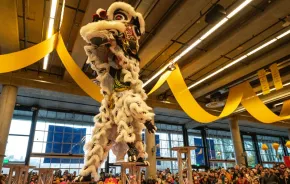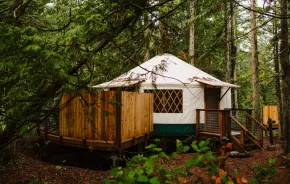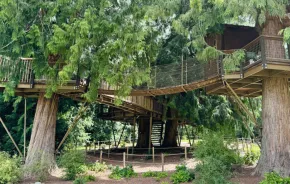
Is your family bracing for a possible Northwest winter with too much sun and not nearly enough snow? Not so fast. Gobs of the beautiful white stuff are on tap for the Cascades this winter according to the trusty Old Farmer’s Almanac. We’ve found four fantastic adventure trips that will foster new outdoors skills and family bonding. And yes, there’s a no-snow option here, just in case.
1. Backcountry skiing hut to hut
A common winter vacation for European families is to tour the Alps on skis, stopping to rest or overnight in cozy, wood-fire-warmed huts along the way. This classic winter adventure has been replicated in the Northwest in several Cascade locales. More good news is that you don’t need to be hardcore Nordic skiers to enjoy a few snowbound nights in Cascadia’s backcountry huts. All you need are skis and hut reservations.

The ultimate destination: Methow Valley
About four hours northeast of Seattle, the Methow Valley is a cross-country skiing paradise with a 120-mile network of groomed trails that is the nation’s largest. One of the best ways to access these trails is via the Rendezvous Huts, five off-grid wood-framed cabins scattered on the ponderosa pine–dotted slopes above Mazama, and right off the trails. Each is about five miles from the next and situated to enjoy cross-valley views of the craggy Gardner Mountain range.
Reserve a string of the huts and ski from one to the next, or do what most first timers do and base camp your family in one hut, exploring loops and interconnecting trails at your leisure. The trails are at a gentle grade and regularly groomed, so while older children can ski on their own, you could pull infants and toddlers in a tow-behind ski sled.
Each cozy hut sleeps up to eight people and features a full kitchen with a propane stove and oven, plus cookware and utensils. A cast iron wood stove keeps each cabin toasty warm, propane lanterns provide light, and the bunk beds and loft are lined with sleeping pads. An outhouse is just outside. Each cabin is stocked with a unique assortment of cards, board games and books. Firewood and drinking water (5 gallons per night) are provided, as is trash removal.
Cooler than cool: You can lug your gear to your cabin’s doorstep in backpacks, but families should consider splurging on the snowmobile freight haul, which frees you to pack all the food, bottles of wine, stuffed animals and duvets your family needs (up to 300 pounds).
Info and reserve: The huts reserve up to a year in advance and weekends book out early, though with a well-timed phone call you may be able to snag a prime weekend due to cancellations. Winter nightly rates per hut range from $150 to $200, and gear hauls are $85 each way. They also have a family special for $350 (Sunday–Thursday), which includes two hut nights and two freight hauls. Adults pay a daily trail pass fee to ski the trail system, while kids ski free. Get info online, or call 509-996-2148.
Get ready
Cross-country skiing is easy to master once you learn the basic techniques, even for young children. Take classes with REI or at local Nordic centers (Hyak, Stevens Pass). Second Ascent in Ballard has a good selection of used skis, boots and towable sleds; you can also rent gear at Winthrop’s Cascades Outdoor Store.
More like this
On the southwest side of Mount Rainier, Mount Tahoma Trails Association manages Mount Tahoma Huts, three chalet-type huts and a yurt, each fully furnished and with a kitchen. The huts are free with a modest reservation fee. About half of the 50 miles of ski trails in the network are groomed. In Mount Hood’s White River valley, ski or snowshoe to three rustic Cascade Huts; the closest is a two-mile journey ($150 per night).
2. Snowshoeing in a Cascade wonderland
If you can walk, you can snowshoe. There are no special skills required, and snowshoes give you immediate access to the winter wonderland of Northwest mountains. Gear is basic and affordable, just a pair of snowshoes that strap on to a regular pair of waterproof hiking boots or snow boots. Most people use hiking poles for added stability.

The ultimate destination: Mount Rainier
If you seek a whole mountain’s worth of snow, Rainier is your mountain. Make your base the historic National Park Inn at Longmire. You can set out on snowshoes on one of the forested trails that depart from the lodge, or head up to Paradise for a snowshoe trek with panoramic views across to the Tatoosh Range.
From Longmire, total novices and small children can get a feel for walking in snowshoes on the flat Trail of the Shadows interpretive loop (0.7 mile round-trip) through old-growth cedar and fir trees laden with snow.
If you long for a view of powder-topped peaks and your family is willing to climb to reach it, take the Rampart Ridge Trail (4.6 miles round-trip, 1,300 feet elevation gain), which branches off the Trail of the Shadows.
You’ll have to drive up to Paradise for two of Rainier’s most famous snowshoe routes through open snowfields and meadows to stunning views: Panorama Point (5 miles round-trip, 1,300 feet elevation gain) and Mazama Ridge (6 miles round-trip, 900 feet elevation gain).
Cooler than cool: Mount Rainier park rangers lead free guided snowshoe walks from Paradise for families with older children (ages 8 and up) every winter starting in mid-December, if enough snow.
Info and reserve: The National Park Inn at Longmire has 25 cozy guest rooms, all but seven with private baths. Perks include a fireplace lounge and hearty breakfasts at the Inn’s restaurant (from $119).
Get ready
Stair-climbing or hiking with elevation gain will build up strength and endurance for snowshoeing. The most important consideration is choosing a trail that has little to no potential for avalanches and checking to ensure avalanche conditions in the backcountry are low the day you plan to hike.
More like this
Scottish Lakes High Camp is an alpine retreat nestled high in the Chiwaukum Mountains west of Leavenworth, which you can only access by skis or snowmobile (in the winter). Nine rustic, cozy cabins are surrounded by a fabulous network of snowshoe and ski trails; a main lodge with full kitchen serves as the communal gathering spot for guests; and outside is a wood-fired sauna and open-air hot tub for stargazing. Look for special family weekend rates (rates vary by cabin and number of people).

3. Sledding on snowy slopes
Forget the expensive lift tickets and fancy gear — all your family needs for a day of snow play are sleds, snow and a hill. Sledding and tubing deliver the exhilarating thrill of downhill skiing without the steep learning curve and expense. And kids get great exercise trudging up the hill all day for yet another plunge. So grab your sled, saucer, toboggan or catamaran; pack a thermos of hot cocoa; and pile on the warm layers for a marvelously old-school adventure.

The ultimate destination: Sunriver Resort
Central Oregon is a powder enthusiast’s winter playground, and the place to park your family in the thick of it is Sunriver Resort in southwest Bend, a resort that is set on a huge expanse of ponderosa pine forestland along the Deschutes River.
For a quick thrill, check out the sledding and tubing hill at Sunriver (ages 4 and up, tubes provided). The real fun begins up the road, though, at Mt. Bachelor Snowblast Tubing Park, a pay-to-play bowl featuring six tubing lanes and two towropes. Rubber rollers accelerate the downhill experience, bouncing and spinning you downward, and a convenient lift carries you back up. Tubes provided ($20–$25 per person for a two-hour session, kids must be at least 42 inches tall).
Cooler than cool: A few nearby Sno-Parks have hills for great vintage-style sledding. Try Wanoga Sno-Park on Highway 46, about 20 minutes from Sunriver, an established sledding hill popular with local families on sunny winter days (Sno-Park permit $4 daily, $25 annual).
Info and reserve: Book a room or suite in the grand Northwest-style lodge at Sunriver or a private condo or vacation home (with hot tub!). The grounds feature on-site restaurants, an indoor pool and fitness center, miles of Nordic ski trails, an ice skating rink and, of course, super downhill skiing at Mount Bachelor (Sunriver lodge rooms from $125 nightly).
Get ready
Sleds, saucers and toboggans seem to fly off the shelves when the snow falls, so it’s a good idea to get yours in advance of your trip. Wear helmets.
More like this
For a close-to-home sledding adventure, head to Suncadia Resort in Cle Elum, where you’ll find a tubing hill with rope-tow return ($20 for 10 rides, ages 3 and up). Deluxe lodge rooms start around $200 nightly. On your way back, stop at Hyak Sno-Park at Snoqualmie Pass for a more traditional sledding hill experience (Sno-Park pass required, $20 daily or $40 seasonal).

4. Winter yurt camping
If the thought of winter camping sounds about as appealing as snuggling with ice cubes, we’ve got two words that will warm you to the idea: heated yurts. Twenty years ago, the number of yurts in Northwest campgrounds could be counted on one hand (there were just two, at Oregon’s Cape Lookout State Park). Today they number in the hundreds and are wildly popular. The good news is that many of these yurts are available in the winter months, too, offering a chance to experience the winter backcountry in rustic comfort. Walled with sturdy, weatherproof canvas on wooden platforms, these domed tents are simply furnished, and have electricity and heat, windows and locking doors.
The ultimate destination: Deschutes National Forest
At Crescent Lake Campground in Oregon’s Deschutes National Forest (about a six-hour drive from Seattle), three domelike yurts overlook a placid mountain lake ringed with fragrant pines. What sets this place apart from the dozens of other yurt winter camping opportunities? The flat, scenic 15-mile loop trail around the lake for cross-country skiing or snowshoeing. You can depart on skis right from your yurt’s front porch. The yurts are also within walking distance to Crescent Lake Resort, which has a little restaurant and shop for essentials.
This is still camping, though — the bathroom facilities are a short walk away, and yurts don’t have kitchens, and you have to cook outside on a camp stove or a fire pit with grate. But winter is arguably the best season to enjoy the cozy warmth from a campfire (no fire bans!).
Info and reserve: Each yurt sleeps five people. No pets are permitted inside ($30 nightly).
Get ready
Your gear packing list for winter yurt camping will be very similar to your summer camping list, with a few changes. No tent or sleeping pads needed; instead pack extra comforts that will keep you fabulously warm: cozy blankets, hot water bottles, down booties, and lots and lots of hot cocoa.
More like this
Stay close to Puget Sound by booking one of the six yurts at Snohomish County’s River Meadows Park, set in an old homestead and orchard at the foot of the Cascades. Three of the yurts sleep five, and the rest sleep up to eight people. The best part? You’ll find availability here on short notice (from $41).
Winter safety tips
- Wear clothing that wicks moisture and sweat away from the skin to stay warm and dry.
- Dress in layers, ending with a waterproof jacket. Make sure kids keep their toes toasty with wool or synthetic socks, and waterproof boots. Keep heads covered with cozy hats, and protect eyes and skin with sunglasses and sunblock.
- Pack the backcountry essentials in your backpack in case of unexpected emergencies: first-aid kit, topographic map, compass, food and water, flashlight and fire starter.
- Check trail and avalanche conditions and the weather forecast dutifully, but even on clear days be prepared for the unexpected.











